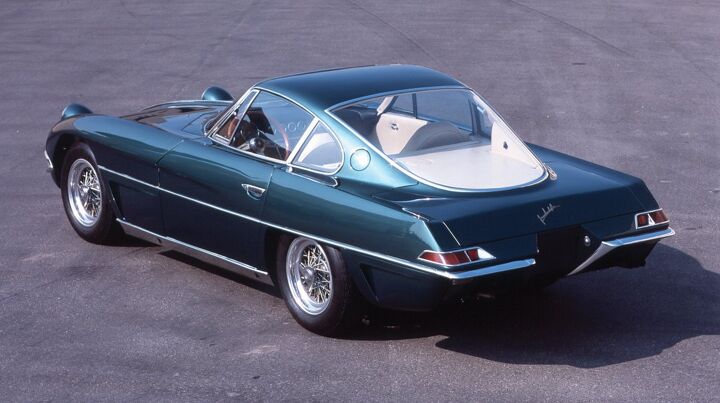Rare Rides Icons: Lamborghini's Front-Engine Grand Touring Coupes (Part I)

I was reminded the other day (by Facebook) about a particularly beautiful coupe I’d photographed at a local car show in 2014. It had two doors, a big engine in the front, svelte and restrained styling, and a Lamborghini badge on the nose. It’s easy to forget that Lamborghini made elegant grand touring coupes long before it got to the likes of the outrageous Countach or LM002. We start at the beginning, with the company’s very first prototype, the 350GTV.
Lamborghini was founded by Ferruccio Lamborghini (1916-1993) in 1963. Mister Lamborghini was already a captain of industry and founded another four-wheeled vehicle business in 1948. It was Lamborghini Trattori, which made tractors. With Automobili Lamborghini, Ferruccio intended to put forth an Italian competitor to the biggest sports car brand in the business: Ferrari. The company’s headquarters was established in the city of Bologna, where it remains today.
Enzo Ferrari was dominating motorsport and exotic passenger cars around the time with his front-engine, rear-drive vehicles. Lamborghini decided to go a different route and put the engine in the middle instead. A mid-engine layout made for a clear difference in product between Lamborghini and Ferrari. Ferrari had only produced its first mid-engine car in 1961, the 246 SP racing car. Ferrari wouldn’t produce a mid-engine passenger car until the Dino 206 GT in 1967, and that didn’t actually have a Ferrari badge on it (as the marque experimented with the Dino sub-brand).
The detail above is why the exotic-looking and mid-engine Miura of 1966 received all the excitement and attention and is the car most think of when considering “the first Lamborghini.” But that’s incorrect: The first product Lamborghini produced just a year after the company’s 1963 inception was the front-engine 350GT, and it was based on a prototype called the 350GTV. While Lamborghini prepared to go big with the Miura a couple of years later, a more traditional front-engine GT car was a well-advised way to introduce the brand to consumers. Once Lamborghini was founded, the GTV was worked up quickly so it could make an appearance at that year’s Turin Auto Show.
The GTV’s development was managed by Lamborghini’s lead engineer Gianpaolo Dallara (1936-), his assistant and future engineer of the Countach Paolo Stanzani (1936-2017), and the company’s imported driver and engineer, New Zealander Bob Wallace (1938-2013). The prototype’s initial chassis was designed by a name we’ve heard before on these pages, Giotto Bizzarrini (1926-).
Bizzarrini’s chassis design was basically what one would find in a race car, a tubular spaceframe. The tube frame was reworked by chief engineer Mr. Dallara into a more typical square tubing design. While heavier, the design was less complicated to build and would later be used in production Lamborghinis.
Bizzarrini was also responsible for the GTV’s V12 engine, and he created a legend. The V12’s 3.5-liter displacement was used for the prototype’s name, back when car naming was a much simpler thing. The GTV lettering stood for Grand Tourer, and Veloce (fast). Ferruccio Lamborghini was dead set on beating Ferrari, and it’s rumored he paid Bizzarrini a bonus for every additional horsepower the V12 mustered over Ferrari’s own V12.
The engine developed for the GTV prototype was the same one Lamborghini used in its production vehicles for decades. Versions of it continued in use through 2009, when the Murcielago concluded its run. A 60-degree DOHC design, the engine was meant from the start to be more advanced than Ferrari’s SOHC V12.
Lamborghini put a prototype version of the engine into the GTV and tested it as soon as possible. The new 3.5-liter managed 370 horsepower and revved to a high-strung 9,000 rpm. Bizzarrini was very pleased with his engine design and assured Ferruccio that he could get 400 horses out of it if he was allowed to fit a more aggressive fuel delivery system. But Lamborghini did not sign off on further edits and determined 370 horses were plenty. The GTV’s power was delivered to the rear wheels by a five-speed manual produced by ZF.
Ferrari had produced V12 engines since 1947 when it started with the tiny 1.5-liter in the 125 S racing car. In 1963 it produced two different displacements of V12, in three different versions: The Tipo 128 (3.0L), Tipo 168 (3.0L), and the Tipo 163 (4.0L). Of note, that Tipo 163 managed 335 horsepower, a big win for Lamborghini.
However, the prototype engine was not yet fitted with the required production carbs and other necessary management systems, nor had it been tuned for everyday GT car use. Under those revised conditions, the engine managed 280 horsepower. But 370 was a great figure to tout for a prototype that didn’t need production running gear. Lamborghini also claimed a top speed of 170 miles per hour, but never actually drove or tested the GTV to any extent. More on that later.
Nevertheless, the prototype was fitted with a real independent suspension that had wishbones front and rear, as well as shocks and coil springs at all corners. The 170-mile-per-hour coupe was theoretically halted from its maybe top speed by four disc brakes.
Lamborghini wanted to top Ferrari in styling as well and contracted with Franco Scaglione (1916-1993). Scaglione had penned exotic-looking vehicles since the early Fifties, including Alfa Romeo’s Berlinetta Aerodinamica Tecnica (BAT) cars. Scaglione started sketching and worked closely with Ferruccio Lamborghini on every aspect of the GTV’s appearance.
Lamborghini was inspired by extant European grand touring coupes of the early Sixties and ordered up a sleek teardrop shape from Scaglione. The GTV’s long hood sported a strong ridge in the middle trimmed with chrome. It extended down to meet the center of the grille, which was separated into two ovoid sections by a chrome spear. There were no bumpers to speak of, only a chrome outline around the grille openings. Headlamps at the front were hidden, a flip-around design that was uncommon at the time.
Most of the GTV’s front end was a single piece of metal, hinged at the front. That allowed for superbly smooth lines all the way to the uniquely curved A-pillar. The side of the GTV was largely without ornamentation. Only a thin chrome strip was present, placed halfway down the GTV’s body, and extended all the way to the rear. The fender formed a soft character line that ran along the forward flanks of the coupe, but it was blended and became softer as it headed to the rear. The coupe was made to look a bit leaner via its chrome lower rocker panels.
At the rear, the chrome trim from the side took a sharp right angle inward, and turned again at the exterior of the license plate to head downward and underneath the car. The trim drew the eye to a unique feature of the GTV: Two sets of three small exhausts. Compared to the flowing lines of the front end, the GTV’s rear was much sharper. Brake lamps were slim and wrapped around the rear at sharp angles.
Above the lamps was a strong character line that ran along the angled trunk lid. Said lid sported Ferruccio Lamborghini’s artful signature in full. His signature was also present on the hood, placed to the right side along with an offset Lamborghini logo. The coupe’s roof pillars flowed back to wrap around a large U-shaped rear window. The exterior look was completed by suitably sporty Borrani wire wheels.
The GTV’s interior was not exceptional for the time; just what one would expect from a Sixties Italian coupe. It was finished in cream leather with a nice wooden wheel, large gauges, and switches with tiny labeling. The cream interior matched nicely to the exterior’s glistening blue-green metallic paint.
Lamborghini was not set up to build the GTV prototype themselves, so when the design was finished the work was handed off to Carrozzeria Sargiotto. Located in Turin, Italy, Sargiotto was not a builder of full cars, nor was it a workshop of diverse skills. Most of the work done by Sargiotto previously was in molds required for the production of plastics. As the plastic mold artisans toiled away at the aluminum and steel body of the GTV, they imbued it with poor fit and finish.
Shoddily built on a short timeline with a race-ready V12, the 350GTV was prepared for its debut at Turin, right? Well no, not at all. There were several hurdles still in the way. More on that in Part II.
[Images: Lamborghini]

Interested in lots of cars and their various historical contexts. Started writing articles for TTAC in late 2016, when my first posts were QOTDs. From there I started a few new series like Rare Rides, Buy/Drive/Burn, Abandoned History, and most recently Rare Rides Icons. Operating from a home base in Cincinnati, Ohio, a relative auto journalist dead zone. Many of my articles are prompted by something I'll see on social media that sparks my interest and causes me to research. Finding articles and information from the early days of the internet and beyond that covers the little details lost to time: trim packages, color and wheel choices, interior fabrics. Beyond those, I'm fascinated by automotive industry experiments, both failures and successes. Lately I've taken an interest in AI, and generating "what if" type images for car models long dead. Reincarnating a modern Toyota Paseo, Lincoln Mark IX, or Isuzu Trooper through a text prompt is fun. Fun to post them on Twitter too, and watch people overreact. To that end, the social media I use most is Twitter, @CoreyLewis86. I also contribute pieces for Forbes Wheels and Forbes Home.
More by Corey Lewis
Latest Car Reviews
Read moreLatest Product Reviews
Read moreRecent Comments
- Turbo Is Black Magic My wife had one of these back in 06, did a ton of work to it… supercharger, full exhaust, full suspension.. it was a blast to drive even though it was still hilariously slow. Great for drive in nights, open the hatch fold the seats flat and just relax.Also this thing is a great example of how far we have come in crash safety even since just 2005… go look at these old crash tests now and I cringe at what a modern electric tank would do to this thing.
- MaintenanceCosts Whenever the topic of the xB comes up…Me: "The style is fun. The combination of the box shape and the aggressive detailing is very JDM."Wife: "Those are ghetto."Me: "They're smaller than a Corolla outside and have the space of a RAV4 inside."Wife: "Those are ghetto."Me: "They're kind of fun to drive with a stick."Wife: "Those are ghetto."It's one of a few cars (including its fellow box, the Ford Flex) on which we will just never see eye to eye.
- Oberkanone The alternative is a more expensive SUV. Yes, it will be missed.
- Ajla I did like this one.
- Zerofoo No, I won't miss this Chevrolet Malibu. It's a completely forgettable car. Who in their right mind would choose this over a V8 powered charger at the rental counter? Even the V6 charger is a far better drive.





































Comments
Join the conversation
Clearly it' a timeless elegant design. That's said it's all smooth, rounded, and curvilinear until you get to the rear where there is that small assortment of sharp edges and straight lines of the tail lights and the left and right rear corners of the body that just feel out of place.
Wow, that's from way back when real auto stylists roamed the earth.